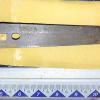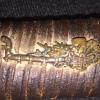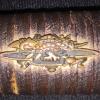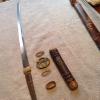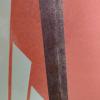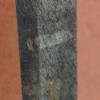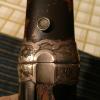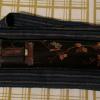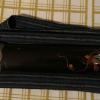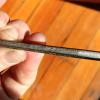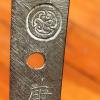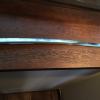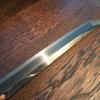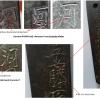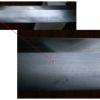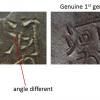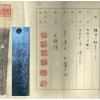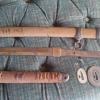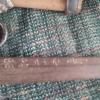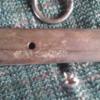|
|
|
|
|
|
Submitted by msm1954 on Sun, 2017-07-30 14:33
|
Can someone help me translate the writing on this Japanese sword. The story is my uncle brought it home from World War II, said he got it "off of a" Japanese soldier, but I doubt that. :) Thanks so very much!
Marilyn
|
|
|
|
|
|
|
|
|
|
Submitted by Candleabra1959 on Sun, 2017-07-16 22:40
|
I note an auction in London tomorrow 17th July has a 'signed Hikashiro Sadamune' wakizashi. You can find it on google if you do a search
Now my understanding is that there is only one signed Sadamune in existence - a tanto. So this would suggest this is a great unaccounted for signed Sadamune or a gimei. The image of the nakago is very unclear as it is very badly pitted and the inmages of the blade are not sufficient to make any judgement on quality.
Interested in the process of auction houses selling Japanese blades and their descriptions, when there is obviously no paperwork.
Andy
|
|
|
|
|
|
|
|
|
|
Submitted by saipan59 on Fri, 2017-07-14 19:17
|
I seem to have too much free time today, so I took the image from "Candleabra's" post and marked the matching strokes between his and the known-good examples, using colors to match the strokes.
I don't follow your comment about 'horizontal' vs 'vertical' on those particular strokes (the purple ones) - all examples are horizontal. Perhaps you're misinterpreting the equivalent strokes.
In red color, I marked the differences that I think are most obvious, and a likely indication that they were written by different people.
The diffs that I think are the most important are:
|
|
|
|
|
|
|
|
|
|
Submitted by Candleabra1959 on Sun, 2017-07-09 13:05
|
I am having trouble translating the characters on this nakago. It is the reverse of the nakago so I assume its the details of date etc, rather than the smith.
Also, is it relevant that the characters seem to be 'hanging off the edge' - ie, seem very close to the edge? Visually this seems odd to me?
Just received the Kokan Nagayama hardback - Connoisseur's Book of Japanese Swords - a very steep learning curve obviously. Unbelievably detailed - I don't know where to start.
Thanks for the recommendation.
Cheers
Andy
|
|
|
|
|
|
|
|
|
|
Submitted by Jan2017 on Mon, 2017-07-03 18:55
|
|
|
|
|
|
|
|
|
|
|
Submitted by karimasaichibu on Tue, 2017-06-20 16:13
|
I just added this sword it was a nice find at a garage sale .
|
|
|
|
|
|
|
|
|
|
Submitted by benjamin1982 on Sun, 2017-06-18 22:51
|
I'm attaching two pictures of Menuki. One of them appears to be a smoking pipe, however it could be something else. Does anyone have thoughts, ideas, and/or opinions about them?
Thank you
|
|
|
|
|
|
|
|
|
|
Submitted by benjamin1982 on Wed, 2017-06-14 00:09
|
Hello- I have had this Wakizashi sword for almost 20 years. It was handed down to me form my Grandfather who served in WW2. I know almost nothing about it and appreciate any comments as to its origin.
Thank you,
Ben
|
|
|
|
|
|
|
|
|
|
Submitted by Candleabra1959 on Mon, 2017-06-05 17:11
|
Hi,
Just wondering about some very basic or obvious aspects of a signature on a nakago.
This one appears to say Bitchu No Kami Yasuhiro - I used Pete's Kanji ID List to decipher - thanks.
I realise that a great blade is a great blade and that is the most important aspect, and I appreciate that, but I just wanted to dwell on signature in respect of this blade.
|
|
|
|
|
|
|
|
|
|
Submitted by Candleabra1959 on Mon, 2017-05-29 14:36
|
I can see why Tsuba are a separate entity for collectors. This one is an iron tsuba - is iron used because it is cheaper than bronze or easier/harder to work or some other reason?
Is it possible to roughly date just by shape and design, when there is no signature present? Has this shape got a specific name? It is almost like a rounded, soft octagon. It is 70mm by 62mm by 3mm thickness. A dragon - not sure what it's doing?
|
|
|
|
|
|
|
|
|
|
Submitted by Candleabra1959 on Mon, 2017-05-29 14:19
|
I am a novice when it comes to Japanese blades, but when it comes to Tsuba, I am not even as accomplished as a novice.
Please refer to the 2 No. images attached. It is bronze, with no signature and measures 65mm by 61mm by 2mm thickness - so not quite circular in shape.
Is it possible to date, given stylisation and theme, butlack of signature?
What do the figures and lion or dog represent?
Is the gold a plating or solid gold or not in fact gold at all?
Thanks
Andy
|
|
|
|
|
|
|
|
|
|
Submitted by Candleabra1959 on Tue, 2017-05-16 13:53
|
I have another wakazashi where I am having trouble deciphering the tang signature and consequently the age of the blade. I'm told it's Meiji period. Have added photos in a PDF showing tang with signature and also signature on kozuka, which is different.
|
|
|
|
|
|
|
|
|
|
Submitted by Bucky45 on Mon, 2017-05-15 03:35
|
Greetings, I just discovered this site and how extensive it is. I was hoping to have some translation help so I can find the Smith on this site and do some of my own research. Thanks for all the help and I'll post pictures of the blade soon.
|
|
|
|
|
|
|
|
|
|
Submitted by Bucky45 on Sun, 2017-05-14 03:13
|
Greetings,
I am new to this informative site and was wondering if I may receive input into this small Tanto. Any information is appreciated. Thank you for your time and looking forward to your comments.
|
|
|
|
|
|
|
|
|
|
Submitted by SRSchoner on Mon, 2017-05-08 18:08
|
(Accidentally placed in my blog and now re-posted here in this forum)
I am new to this club and hope to find some information regarding a WW2 Gunto "Bring Back" sword.
|
|
|
|
|
|
|
|
|
|
Submitted by bogdan.angheloiu on Mon, 2017-05-08 11:51
|
I bought a sword from Japan with characteristics presented below:
Very antique sword of more than 590 years old, which was smithed by Sue-Tegai (末手掻), one of major swordsmith school, as attested by NBTHK "Kantei-sho" certificate.
Mei signature: Mumei, i.e. no signature, however, NBTHK attests in its "Kantei-sho" certificate that this sword was smithed by Sue-Tagai (末手掻).
● Jidai date: around Oei era (応永, 1394-1427)
● NBTHK "Kantei-sho" certificate: Status is Hozon (保存, i.e. to be preserved). Dated June 1, 2016, and numbered 3012349.
|
|
|
|
|
|
|
|
|
|
Submitted by Candleabra1959 on Sun, 2017-05-07 12:46
|
I've attached a few images of another of my wakazashi. I admit I bought this unseen, on a whim, which for a beginner is probably not a good idea. I know the advice is to read and read before making a purchase but the internet makes it so easy to just click and buy.
Anyway, I attach a picture of the tang and its signature - whether that be genuine or fake, I believe it reads - Kawachi No Kami Fujiwara Kunisuke.
It came with a nice iron Tsuba, also images attached.
|
|
|
|
|
|
|
|
|
|
Submitted by Candleabra1959 on Thu, 2017-05-04 16:21
|
I have only recently become interested in the art and history of Japanese swords and have a few wakazashi which I am trying to verify as to era and swordsmith.
I am aware that there are fakes around (Chinese/other?) and also original swords that have fake signatures, just to confuse matters.
I have attached a PDF with three slides/images - finding it very hard to photograph the blade.
|
|
|
|
|
|
|
|
|
|
Submitted by Mark van Es on Tue, 2017-05-02 10:23
|
So, i'll be in Berlin between the 15th and the 19th of this month and i was wondering does anybody know of any events or places to go to relating to nihonto and katana?
|
|
|
|
|
|
|
|
|
|
Submitted by Ericarae on Mon, 2017-04-10 01:45
|
I have a WWII Katana hat was brought home from the battle at Iwo-Jima. It us dated May 20 1945 but is signed Tadamichi. The only Tadamichi I have discovered dates around 1680. I would love to find out everything I can about this Katana.
|
|
|
|
|
|
|


